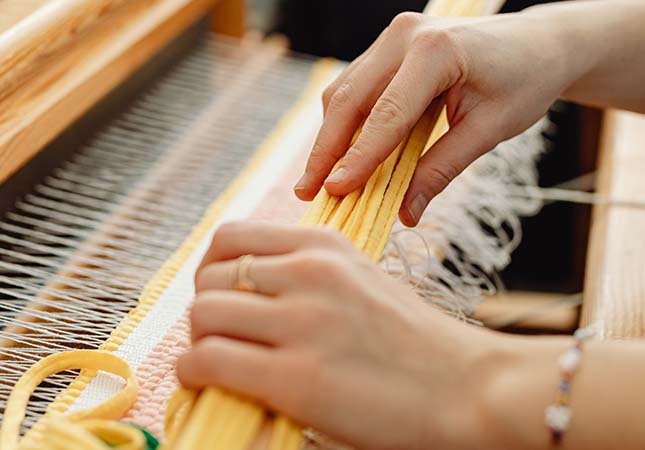Throughout history, clothing has played a significant role in our daily lives, starting from primitive times. In addition to providing us with sustenance, shelter, and energy sources, the production of clothing has a considerable impact on the environment. Among the numerous techniques employed to create garments, knitting stands out as one of the oldest. Hand-knitting, requiring nothing more than needles and yarn, has become the most accessible and practical craft due to the vital role clothing plays in our lives. In the modern era, an array of knitting and loom machine has emerged, revolutionizing the knitting process by enhancing automation and efficiency.
Hand Knitting
The art of hand-knitting has paved the way for modern knitting techniques. Its origins can be traced back to the Middle East, where it eventually spread its influence to Europe. Compared to the broader textile industry, the knitting sector is relatively young, yet it boasts a rich history spanning many years. In China, specifically, the knitting industry has flourished for only around 80-90 years. Looking back to the era of primitive humans, we find evidence of hand-woven knitwear in the form of fishing nets skillfully crafted by our ancestors. Initially, hand-knitting involved using wooden needles to loop and interweave yarns, resulting in simple and coarse fabrics. Over time, this method evolved into a cottage industry, marking the origin of both modern weaving machines and the fundamental process of clothing and fabric production.

The invention of the multi-heald-threadle machine during the Chinese Han Dynasty marked a significant breakthrough in knitting technology, simplifying the knitting process and doubling production efficiency. Building upon the advancements made by preceding dynasties, the British introduced the hand-pulled shuttle (also known as the flying shuttle device) and the power loom, laying the foundation for the "ordinary loom machine." In the 1950s, the quest for enhanced productivity led to the emergence of various shuttleless looms, including projectile looms, air-jet looms, water-jet looms, and rapier looms. Subsequently, in the 1990s, the French introduced the jacquard machine, which enabled the weaving of intricate multi-color weft fabrics. As the modern age unfolded, a diverse array of weaving machines were created to cater to humanity's evolving clothing needs, transitioning from providing mere shelter to encompassing fashion as well.
To gain a better understanding of weaving machines, let's delve into the different types of these machines:
1. Categorized by process type:
Weaving machines can be classified based on the process they employ. There are two main categories: warp weaving machines and weft weaving machines. Additionally, circular weaving machines are also included. Within the realm of weaving, we further distinguish between air-jet looms and water-jet looms.
2. Differentiating warp knitting from weft knitting:
Warp knitting and weft knitting are distinct techniques with notable dissimilarities. In warp knitting, fabrics are formed by interlooping a group of yarns (warps) in a left-to-right or right-to-left direction. This means that a single yarn can only create one stitch, forming a chain-like structure. Conversely, weft knitting allows for the formation of fabrics using at least one yarn. To enhance production efficiency, multiple yarns are commonly employed in weft knitting. Notably, warp knitted fabrics exhibit a more stable structure and possess less elasticity due to the formation of loopback knots.
From the earliest stages of human civilization, knitting technology, whether in the form of hand-knitting or weaving machines, has had a profound impact on our daily lives. Hand weaving fosters coordination skills and enhances concentration, while the advancement of weaving machines has significantly increased knitting productivity and raised the bar for knitted product expectations.
With a rich heritage and extensive experience spanning decades, SUNTECH Textile Machinery is a globally renowned enterprise. With over 5,000 satisfied customers and installations in 17,000 locations worldwide, SUNTECH Textile Machinery has established a strong network of agents across more than 120 countries. These agents operate in regions such as the Americas, Canada, Italy, Germany, Russia, Mexico, Argentina, Colombia, Peru, Ecuador, Guatemala, Indonesia, Vietnam, Thailand, the Philippines, India, Pakistan, Bangladesh, Sri Lanka, Uzbekistan, Iran, Egypt, South Africa, Syria, Mauritius, and many others.
SUNTECH Textile Machinery specializes in the development, production, and distribution of high-quality Fabric Make-up Machines and Material Storage & Handling Equipment. These offerings are built upon the principles of digitization, automation, and intelligence, ensuring exceptional performance and efficiency.
SUNTECH Textile Machinery has the range of products encompasses almost all fabric types, including but not limited to pinking machine, loom machine, weaving machine, beam truck, fabric cutting machine, motorized beam trolley, beam storage, and fabric inspection machine. SUNTECH Textile Machinery continues to lead the textile industry with its innovative approach and extensive experience. We welcomes quotes and cooperation opportunities with open arms.




